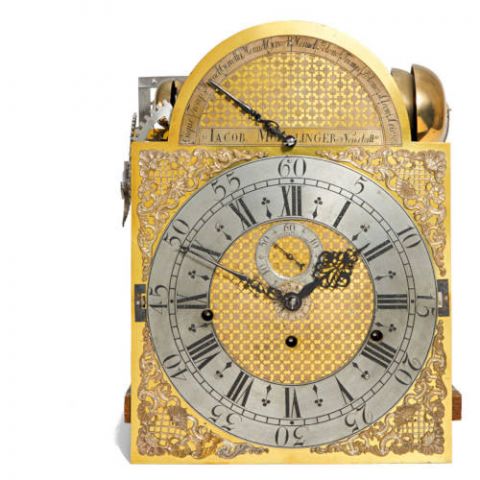
Lot was sold
Lot 43 | Large porcelain service 'Flora Danica'
Estimate
55.000
- 60.000
€
D
Result:
(incl. premium)
64.500 €
LARGE PORCELAIN SERVICE 'FLORA DANICA'.
Royal Copenhagen.
Maker/Designer: Model J.C. Bayer..
Technique: Porcelain, enriched in colours and gold.
Description: 157 pieces consisting of:
1 Presentoir (Ø 33,5cm),
1 tureen (h. 32,5),
1 lidded bowl (h. 17cm/Ø 23,5cm),
2 round dishes (Ø 33cm),
1 dish with curved sides (23x29,85cm),
1 oval dish (44,5x34cm),
1 oval dish (32x40,5cm),
1 oval bowl (24,5x19cm),
2 bowls (21,5x21,5x7cm),
1 sauce boat (23x18x14,5cm),
1 sugar bowl (Ø 8cm),
12 soup bowls (Ø 13cm) + 12 saucers (Ø 17cm),
12 plates with pierced rim (Ø 23cm),
12 plates with pierced rim (Ø 25,5cm),
12 plates (Ø 25,5cm),
12 plates (Ø 17cm),
8 deep plates (Ø 22cm),
12 plates (Ø 19,5cm),
6 cream cups (h.8 cm) + 6 saucers (10x10cm),
8 coffee cups (h. 7cm) + 8 saucers (Ø 13,5cm),
12 mocha cups (h. 6cm) + 12 saucers (Ø 12cm)
.
Mark: Manufacture mark, various year marks, all parts except the saucers, inscribed with Latin plant names.
Flora Danica (lat. Danish flora) is the name of a botanical atlas that was started in 1753
by Christian Oeder, director of the Botanical Garden in Copenhagen. It took 122 years
until the entire flora of the Danish state was recorded in the manner of a herbarium - and
the extensive encyclopedia was completed. In 1790, the Danish Crown Prince and later King
Frederick VI ordered an extensive dinner service from the Royal Porcelain Manufactory in
Copenhagen, which was to bear not only the name but also the motifs of 'Flora Danica'. It
was intended as a gift for the Russian Tsarina Catherine II, who died in 1796, before the
service was completed in 1802. Thus deprived of its original purpose, the service was kept
by the Danish Court, where parts of it are still used for state banquets at Christiansborg
Castle.
Royal Copenhagen.
Maker/Designer: Model J.C. Bayer..
Technique: Porcelain, enriched in colours and gold.
Description: 157 pieces consisting of:
1 Presentoir (Ø 33,5cm),
1 tureen (h. 32,5),
1 lidded bowl (h. 17cm/Ø 23,5cm),
2 round dishes (Ø 33cm),
1 dish with curved sides (23x29,85cm),
1 oval dish (44,5x34cm),
1 oval dish (32x40,5cm),
1 oval bowl (24,5x19cm),
2 bowls (21,5x21,5x7cm),
1 sauce boat (23x18x14,5cm),
1 sugar bowl (Ø 8cm),
12 soup bowls (Ø 13cm) + 12 saucers (Ø 17cm),
12 plates with pierced rim (Ø 23cm),
12 plates with pierced rim (Ø 25,5cm),
12 plates (Ø 25,5cm),
12 plates (Ø 17cm),
8 deep plates (Ø 22cm),
12 plates (Ø 19,5cm),
6 cream cups (h.8 cm) + 6 saucers (10x10cm),
8 coffee cups (h. 7cm) + 8 saucers (Ø 13,5cm),
12 mocha cups (h. 6cm) + 12 saucers (Ø 12cm)
.
Mark: Manufacture mark, various year marks, all parts except the saucers, inscribed with Latin plant names.
Flora Danica (lat. Danish flora) is the name of a botanical atlas that was started in 1753
by Christian Oeder, director of the Botanical Garden in Copenhagen. It took 122 years
until the entire flora of the Danish state was recorded in the manner of a herbarium - and
the extensive encyclopedia was completed. In 1790, the Danish Crown Prince and later King
Frederick VI ordered an extensive dinner service from the Royal Porcelain Manufactory in
Copenhagen, which was to bear not only the name but also the motifs of 'Flora Danica'. It
was intended as a gift for the Russian Tsarina Catherine II, who died in 1796, before the
service was completed in 1802. Thus deprived of its original purpose, the service was kept
by the Danish Court, where parts of it are still used for state banquets at Christiansborg
Castle.
Contact:
Print this lot | Recommend lot |
Conditions of this Lot
VAT margin scheme, VAT included, but must not be indicated, not refundable
29% buyer’s premium on the hammer price
29% buyer’s premium on the hammer price
Estimated Estimated shipping costs for this lot:
Arrangement adter the auction.
Stock Id: 68188-1
More lots which could be of your interest
- Lot 541 (A537)
Royal Copenhagen
TWO DECORATIVELY PIERCED PORCELAIN DESSERT PLATES WITH FRUIT AND NUTSEstimate: 500 - 800 €
20.11.2025 - ca.10:31Works of Art & Art Nouveau | Auction 20.11.2025








